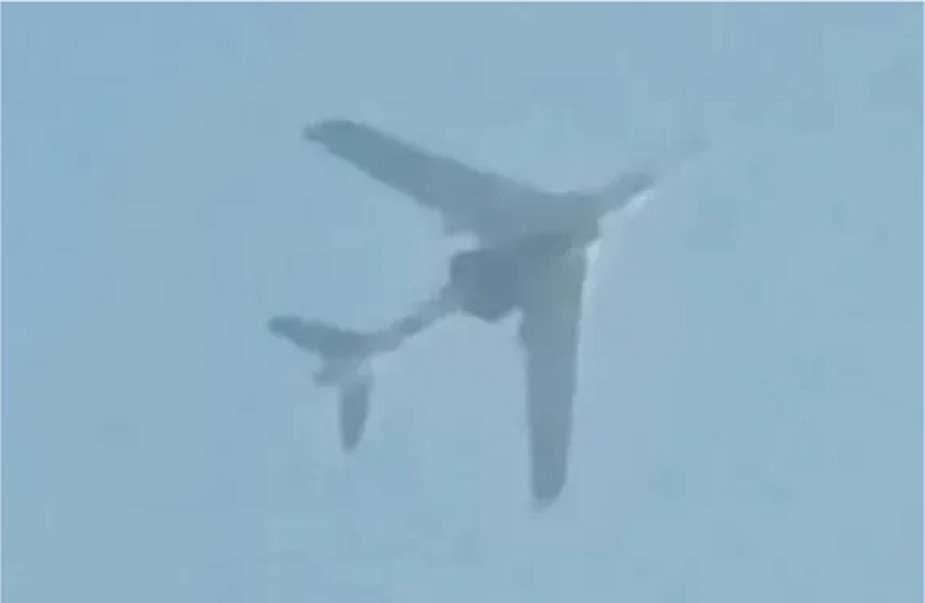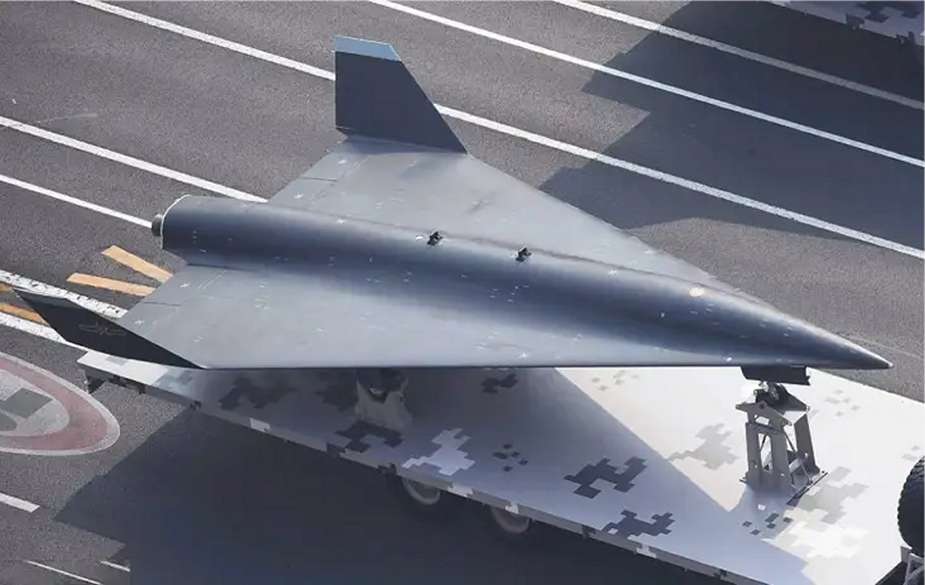What secrets lie with this mysterious supersonic aircraft carried by China's H-6MW bomber?
On April 19, 2024, a picture posted on Chinese social media platforms quickly gained widespread attention by depicting a Chinese H-6 bomber, a pillar of the People's Liberation Army Air Force (PLAAF), carrying an unidentified large, dark-colored aircraft underneath its fuselage. This revelation has prompted discussions and debates regarding the nature and purpose of the mysterious payload.
Follow Army Recognition on Google News at this link

This Chinese H-6 bomber, a pillar of the People's Liberation Army Air Force (PLAAF), is carrying an unidentified large, dark-colored aircraft underneath its fuselage. (Picture source: Chinese social media)
One plausible explanation posits the presence of an upgraded version of the H-6M cruise missile bomber, known as the H-6MW, intended to serve as a launch platform for advanced aerial assets, including the WZ-8 supersonic drone. Further complicating the analysis are the various iterations within the H-6 family, including the H-6N air-launched 'mothership' variant and the H-6N cruise missile bomber. The former, derived from the H-6K version, features a semi-recessed area under the main fuselage for carrying outsized payloads, while the latter, based on the H-6M platform, carries its loads directly under the fuselage.
The H-6 series serves multiple roles within the People's Liberation Army Air Force (PLAAF), functioning both as operational weapon systems and as platforms for testing advanced air vehicles and aerial weapon systems, mirroring the adaptability of the American B-52 Stratofortress and the Soviet Tu-16 Badger. Additionally, it's worth noting that the H-6M variant is distinguishable by its glazed nose, reminiscent of earlier versions of the H-6 and the Soviet Tu-16 Badger from which they are derived while lacking the more efficient turbofans found in newer H-6K/J models. This feature aids in identifying the aircraft and understanding its capabilities within the broader family of Chinese bombers.
However, uncertainties persist regarding the exact nature of the payload. Initially thought to be the WZ-8 rocket-powered supersonic unmanned reconnaissance drone, commonly associated with the H-6 for aerial deployment, closer examination reveals discrepancies in size and configuration, casting doubt on this assumption.
The WZ-8 is a high-altitude, supersonic unmanned aerial vehicle (UAV) developed by the Aviation Industry Corporation of China (AVIC). It is designed for strategic aerial reconnaissance, capable of reaching speeds up to Mach 3 and altitudes around 100,000 feet (30 kilometers). This UAV is equipped with advanced sensors such as synthetic aperture radar and electro-optical imaging, enabling it to perform intelligence gathering over wide geographical areas including potentially hostile territories.
The WZ-8 is usually launched from a H-6M bomber, utilizing rocket power to reach operational altitude after deployment. This launch method is chosen to enhance the UAV's operational stealth and speed, allowing it to perform reconnaissance in high-risk environments typically out of reach for more conventional UAVs. The operational capabilities of the WZ-8 enable it to undertake roles generally fulfilled by satellites, such as collecting targeting data for long-range weapons. This UAV poses a challenge for current air defense systems, requiring adjustments in existing defensive strategies to handle high-speed, high-altitude threats.

Some people believe that this mysterious object could be the WZ-8 high-altitude supersonic reconnaissance drone, which was revealed in 2019. (Picture source: Russian social media)
Details on the WZ-8's deployment and active missions are limited, with few confirmed reports on its operational status. This lack of information aligns with its strategic role, suggesting that it is considered a valuable asset for military reconnaissance efforts with limited public visibility regarding its use. One such example from the U.S. is the rumored RQ-180, an unmanned aerial vehicle designed for high-altitude, stealth surveillance missions.
Discussions are ongoing as to whether this object might be the WZ-8 high-altitude supersonic reconnaissance drone, first revealed in 2019, or the MD-22 reusable hypersonic drone, which was unveiled in 2022. While the MD-22 shares similarities in design and function with the WZ-8, it remains unclear whether the mysterious aircraft showcased in the image represents a variant of either model or a distinct developmental iteration, as reports suggest that China is expanding its research into high-speed drones resembling the MD-22.
Unveiled at the Zhuhai Air Show 2022, the MD-22 Kuancheng hypersonic drone, developed by the Guangdong Aerospace Science and Technology Research Institute, measures approximately 10.8 meters in length and 4.5 meters in width, with a take-off weight of about 4,000 kg and a maximum load factor of around 15%. Serving as a reusable near-space hypersonic technology test platform, its primary purpose is to conduct various aircraft technology verification tests and near-space in-situ scientific experiments. The MD-22 is designed to accommodate different power sources and offers options for autonomous take-off or rocket-assisted launch modes.
According to the manufacturer's information, the MD-22 can operate in a range of Mach numbers between 0 and 7, but according to other reports, the Kuancheng could reach a maximum speed of Mach 8. A key feature of the MD-22 is its rotating detonation engine, a simple yet efficient propulsion system that generates shock waves to propel the aircraft forward. This technology enhances the drone's speed and maneuverability, positioning China alongside the United States as one of the few countries studying such engines.
The MD-22's flight performance is also noteworthy, with the ability to reach altitudes exceeding 100,000 meters and a range of 8,000 kilometers, while maintaining high lift coefficients even at cruising speeds of Mach 6. This ability to maintain stability at Mach 6 cruising speeds, coupled with a possible maximum overload of 16G and a lift coefficient comparable to the F-22, will likely ensure notable maneuverability and evasion capabilities against anti-aircraft systems.

Despite its compact size, which could align with the characteristics observed in the photographed aircraft, the MD-22 can carry a 600-kilogram bomb, making it a platform reportedly capable of carrying nuclear warheads over long distances. (Picture source: Chinese social media)
Moreover, the MD-22 UAV is said to be equipped with communication systems tailored to operate in challenging conditions, including during hypersonic flight. Similar to hypersonic missiles, the extreme velocities of the MD-22 generate a plasma layer due to atmospheric friction, impeding traditional electromagnetic communication. This obstacle has delayed the deployment of hypersonic missiles by the United States, which are still undergoing testing. China's possible successful resolution of this technical challenge is essential for effective control of the MD-22 during high-speed maneuvers.
Despite its compact size, which could align with the characteristics observed in the photographed aircraft, the MD-22 can carry a 600-kilogram bomb, making it a platform reportedly capable of carrying nuclear warheads over long distances. By prioritizing speed and maneuverability, China aims to develop a platform capable of delivering rapid and direct strikes without reliance on concealment measures, which reminds the tactic used by the United States for its SR-71 Blackbird strategic reconnaissance aircraft. Attempts to intercept or shoot down the SR-71 Blackbird, one of the fastest aircraft ever built, were largely unsuccessful. The SR-71, capable of speeds exceeding Mach 3, consistently outran missiles and enemy fighters, including the Soviet MiG-25 and MiG-31. Despite multiple attempts by various countries, no SR-71 was ever shot down by hostile action.
The Soviet Union made numerous attempts to intercept the SR-71 using MiG-31s, employing complex tactics and high-speed maneuvers. However, the SR-71's exceptional speed and altitude capabilities made successful engagement very difficult. Even in a scenario where a missile locked onto the SR-71, its high cruising speed allowed it to simply outrun the threat. The MiG-25, another aircraft deployed in attempts to intercept the SR-71, faced similar challenges, with its radar and missile systems struggling to effectively target the high-speed Blackbird at the extreme velocities involved in an interception attempt.
Amidst these deliberations, one prevailing theme emerges: China is prioritizing the development of a supersonic or hypersonic platform focused on speed and maneuverability to enable rapid and direct strikes, without relying on concealment measures. This emphasis on advanced hypersonic technologies, exemplified by the DF-17 and DF-41 missiles, potentially allows China to engage targets swiftly over long distances with trajectories that are difficult to detect. These capabilities offer both regional and global strike options, posing challenges to adversaries' strategic considerations, notably the United States and Taiwan.
- Hits: 2546
















